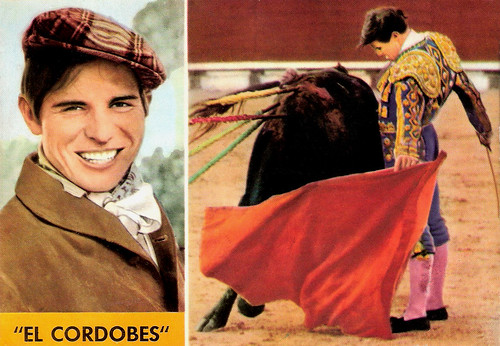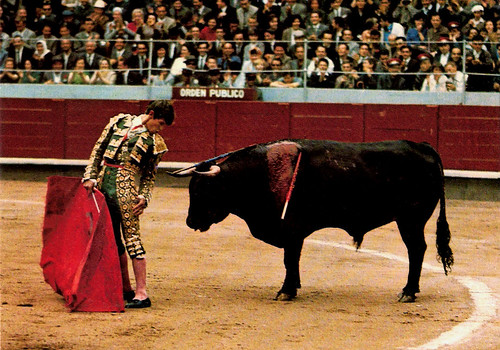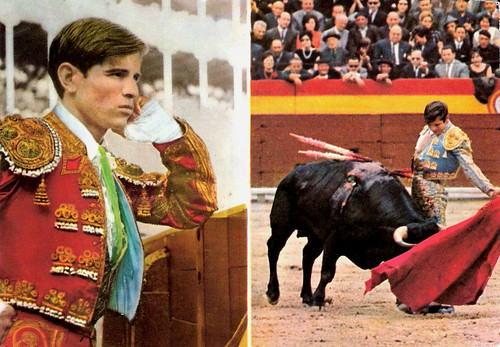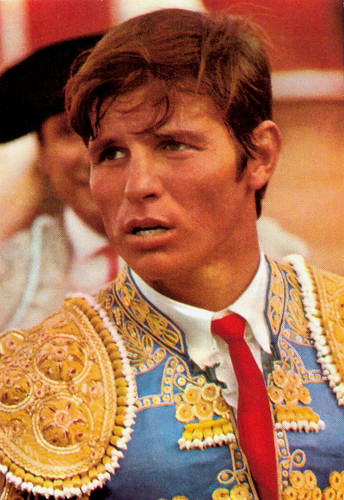
Spanish postcard by A.G.N. Fábregos, no. 70. Photo: Carretero.

French postcard by Edition Cely / Marcel Pendaries, Saint-Alban, no. 1873. Photo: Aubert Kodaks, Bayonne.
A classical tale of rags to riches
The life of Spanish matador El Cordobés (The Man from Cordoba) is a classical tale of rags to riches. Manuel ‘Manolo’ Benítez Pérez was born in the slums in Palma del Rio near the city of Cordoba, Andalucía in 1936. At 9, Manolo was an orphan and was reared in an orphanage, where he dreamed of being the greatest bullfighter in Spain. But he was caught by the Guardia Civil stealing chickens and oranges at nearby farms and was sent to jail for three months.
At 23, he worked as a bricklayer in Madrid and practised bullfighting on untrained bulls at night. Once he vaulted over the fence at a prestigious bullfight and with an improvised cape began taking a bull through its paces. Officials quickly dragged him away, but it was the start of his bullfighting career. Promoter Rafael Sánchez, known as ‘El Pipo,’ bought him cows for practice, dreamed up his stage name, helped fashion his gimmicks - and later protected his growing popularity by bribing journalists to overlook his stylistic faults and the invalid bulls he was fighting.
During the 1960 season, while he was still a Novillero (novice bullfighter), El Cordobés attracted attention throughout Andalusia. He did not attain full rank as a matador until 1963 when he had already become famous. El Cordobés’s antics and daredevil stunts - such as kissing the bull between the horns - attracted extraordinary crowds. He made his film debut in the bullfighting drama Aprendiendo a morir/Learning to Die (Pedro Lazaga, 1962). A year later he appeared in the crime drama Chantaje a un torero/The Blackmailers (Rafael Gil, 1963).
One of the original and dangerous ring techniques practised by El Cordobés was first shown to the world at Anjucar. In a stark departure from formality, he waved his Banderillero (Columpio) away, broke his Banderillas down to 'pencil length', and standing with his back to the bull as it charged, moved his right leg out moments before the bull was upon him, causing the bull to swerve and allowing El Cordobés a moment to slam in the Banderillas from just behind the left horn. This manoeuvre was repeated in bullfights across Spain, sometimes with even more dangerous variations, such as standing with his back to the barerra and driving in the banderillas after the horns passed either side of him.
A significant moment in his career came in 1964 when he made his first appearance at Las Ventas, the bullring of Madrid. Watched on television by many Spaniards, the bullfight ended with the near-fatal goring of El Cordobés on the horns of the bull Impulsivo. Yet twenty-two days later El Cordobés fought again. The press dubbed him ‘the Beatle of the Bullring’. The crudity of his technique was offset by his exceptional reflexes, courage, and crowd appeal. In 1965 he fought in 111 corridas, breaking the single-season record of 109 established by Juan Belmonte in 1919. At up to $50,000 per bullfight, the poor boy from the slums had become a millionaire.

Spanish postcard by A.G.N. Fábregos, no. 60. Photo: Carretero.

Spanish postcard by Chavir, no. 1.221. Photo: C. Rivas, Barcelona.

Spanish postcard by CYP Postales Color, Barcelona, no. 5227. Photo: Campana-Puig-Ferran.

Spanish postcard by Ed. Beascoa, no. 517. Photo: Carretero.
Tired of raising pigs
El Cordobés had a cameo in the French film La vie, l'amour, la mort/Life, Love, Death (Claude Lelouch, 1969) and made his fourth film in the Philippines: the comedy Europe Here We Come! (Ben Feleo, 1971). In the meanwhile, he squired the world's most beautiful women, owned a Rolls-Royce, flew his own aeroplane, and drove his fans into ecstatic fevers but in 1972, he suddenly bowed out.
Reportedly battered by the liquor and pills that were fueling his overloaded 100-fight seasons, He married his French girlfriend Martine who had given birth to two of his children - and retired with a vast accumulated fortune in livestock and real estate. He sometimes appeared on TV and was himself in the film Rafael en Raphael (Antonio Isasi-Isasmendi, 1975) about the singer Raphael.
In 1979, after eight years of retirement, the 41-year-old matador returned to bullfighting, ‘tired of raising pigs’. The Spanish critics gave him top marks for his come-back fight. However, most of El Cordobés' engagements were in second-rate rings, where the audiences and the bulls are less demanding. Following an incident in 1983, when a bull that he was about to fight killed an Espontáneo (‘spontaneous’, a person who illegally jumps into the ring to fight the bull), El Cordobés was much maligned by the press for allowing it to happen. He continued to make occasional appearances as a matador until 2002.
Then after four decades, he retired for good with a bullfight the Las Ventas bullring in Madrid, the sport's most prestigious venue. There he cut off his matador's pigtail, known as a Coleta, ritually ending his bullfighting days. An early biography, 'Or I'll Dress You in Mourning' by journalists Larry Collins and Dominique Lapierre, was published in 1968 by Simon and Schuster. El Cordobés' story was also the basis for the musical Matador (1987) by Mike Leander and Eddie Seago.
According to legend, Benitez fathered many illegitimate children. For years he refused to acknowledge one son in particular, Manuel Diaz, who also entered the bullfighting scene. Later, they reconciled their differences. Today, El Cordobés lives in seclusion near Córdoba.

Spanish postcard by A.G.N. Fábregos, no. 70. Photo: Carretero.

Spanish postcard by A.G.N. Fábregos, no. 87. Photo: Carretero.

Spanish postcard by A.G.N. Fábregos, no. 92. Sent by mail in 1996. Photo: Carretero.
Sources: Isambard Wilkinson (The Telegraph), William B. Lyon (People - now defunct), Encyclopaedia Britannica, Ottawa Citizen, Wikipedia and IMDb.
This post was last updated on 24 October 2023.
I've had a long time fascination with the bullfight (saw two in Spain in the 1980s) so thank you for this.
ReplyDeleteWas so lucky to have seen him fight in the ring once
ReplyDelete